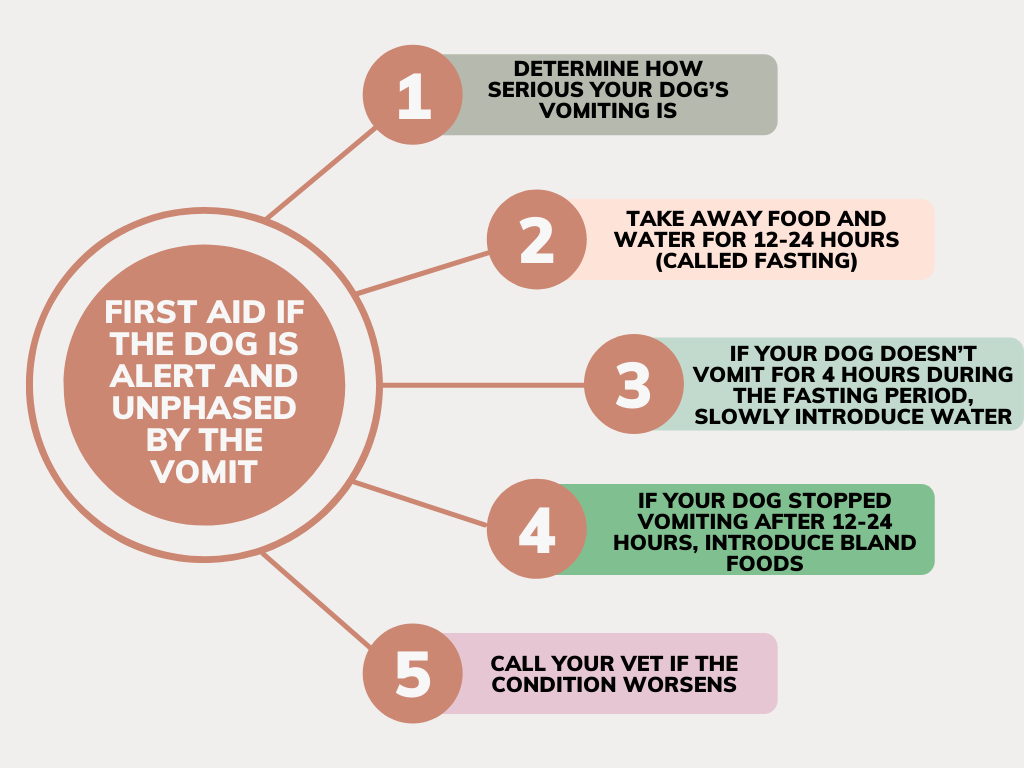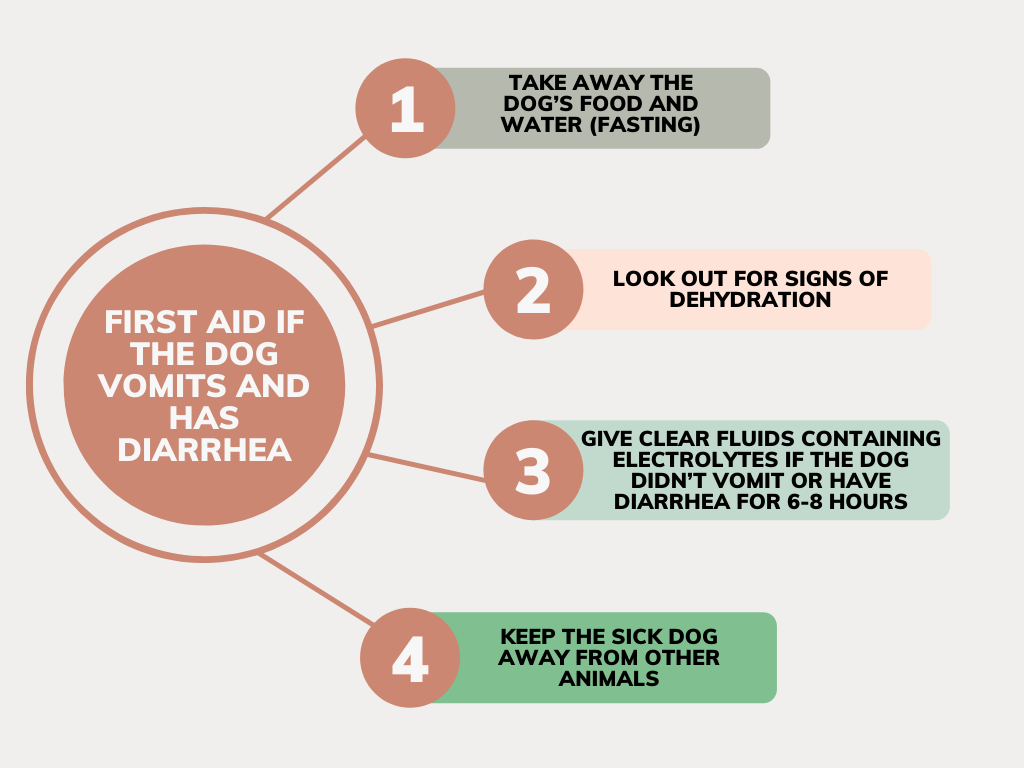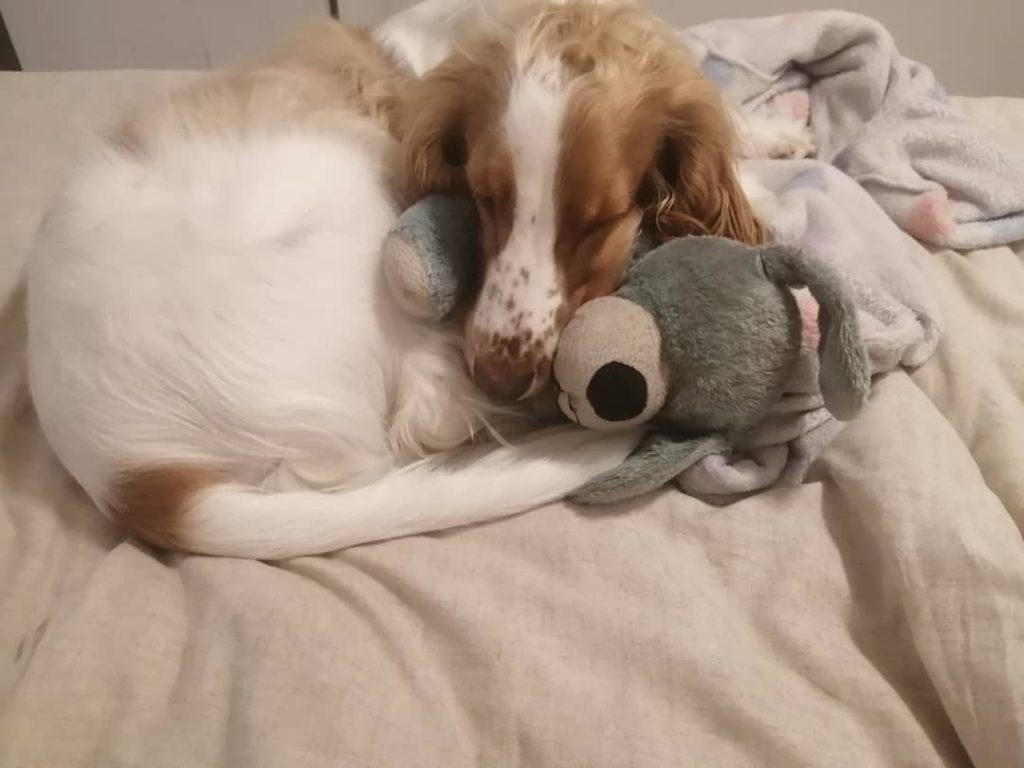It’s scary to see your beloved dog vomiting and even more frightening if you don’t know what to do about it. I’ve had a few similar experiences and had to rely on veterinary advice for future situations. Because I’ve learned through those experiences, I’m excited to share that knowledge with you so you can easily handle the situation.
The first aid for vomiting dogs depends on whether they vomit and are unphased, vomit with diarrhea, or have blood in their vomit. The type of vomit determines the severity of the situation and thus the first aid treatment plan.
So, if your dog is vomiting and you’re concerned, be sure to see how the vomit looks, how frequently your dog vomits, and how your dog behaves. This information is essential to treat your dog at home to the best of your ability. See the first aid for each scenario below.
First Aid if the Dog is Alert and Unphased by the Vomit
The first type of vomit is if your dog is vomiting but still goes about their day as usual. For instance, they play, move around, and seem their usual selves even though they have vomited. It is usually not that serious and needs minor interventions to treat your fur friend back to health.
If your dog is still alert and unphased by the vomiting episode, the first aid steps are:
- Determine how severe your dog’s vomiting is
- Take away food and water for 12-24 hours (called fasting)
- If your dog doesn’t vomit for 4 hours during the fasting period, slowly introduce water
- If your dog stopped vomiting after 12-24 hours, introduce bland foods
- Call your vet if the condition worsens

1. Determine How Serious Your Dog’s Vomiting Is
See if you can figure out why your dog is vomiting. Sometimes it’s obvious to determine, but other times it’s not. For instance, some dogs could vomit once if they ate plants they shouldn’t have. But if you can figure out the cause, you can better manage your dog’s symptoms. There are some reasons you shouldn’t be concerned about and some concerning ones.
Unconcerning Reasons Dogs Vomit
Reasons your dog vomit but you shouldn’t be too concerned about, especially if they’re going about their day, as usual, are:
- Eating table scraps or foods that are too rich for their system to handle
- Becoming intolerant to certain foods
- A sudden change in diet
- Eating plants that they shouldn’t have
- Swallowing foreign objects like plastic, sticks, stones, pieces of rope, or bones
- Getting car sick
- Gastric acid build-up (if a dog goes too long without eating something: this happened with Dixie, my oldest Cocker Spaniel)
- Excessive stress or anxiety
- If the dog ingests a small amount of household cleaning or gardening supplies.
Remember that you don’t have to worry about these reasons only if your dog still acts like themselves and eats and drinks like usual. If your dog’s behavior starts to change or becomes more lethargic, consider taking them to the vet.
As a rule of thumb: take your dog to the vet if you’re genuinely concerned, no matter what you read on the internet. Or, if you can’t afford a consultation, phone your nearest vet to ask for advice. They’ll ask you some questions and tell you whether they want to examine your dog or not.
Juan’Ri Strauss
Concerning Reasons Dogs Vomit
There are more concerning reasons that might cause your dog’s vomiting. Usually, though, your dog won’t act normal in these cases. But, to be sure you’re as informed as possible, here are the more problematic reasons:
- Ingesting poison or large amounts of household cleaners or gardening substances
- Foreign objects stuck in the dog’s throat
- Viral or bacterial infections
- Internal pests like worms
- Bloat or GDV (twisted stomach that can be fatal)
- Heatstroke
- Kidney failure
- Liver failure
- Parvovirus
As I said, dogs aren’t usually able to be themselves for these reasons. Their bodies are affected in multiple ways, which means that other symptoms would accompany the vomiting.
So, if your dog has some of the following symptoms along with the vomiting, consider consulting your vet:
- Fever
- Weightloss
- Dehydration
- Weakness
- Abdominal pain
- Depression
2. Fasting: Take Away Food and Water for 12-24 Hours
If your dog still acts like themselves and doesn’t have any other concerning symptoms, you can try fasting for 12-24 hours.
Fasting means taking away their food and water and not allowing them to ingest anything during this time. Fasting will help your dog’s digestive enzymes to do their work and start the healing process. It will also prevent your dog from vomiting unnecessarily, losing even more fluids than they already did.
Remember that vomiting dogs can quickly dehydrate, but keeping water out may cause your dog to gulp up large amounts, causing excessive vomiting. You start introducing small amounts of water when your dog doesn’t vomit for 4 hours (no matter if they’re still in the fasting stage).
3. If Your Dog Stops Vomiting for 4 Hours During Fasting, Gradually Introduce Water
You might notice that your dog looks pretty thirsty after vomiting a few times. That’s natural because they’re trying to regain their lost fluids. Be careful that your dog doesn’t drink the water too fast. That’s why we only recommend giving small amounts of water at first.
Gradually increasing your dog’s water intake with ice chips and then moving to small amounts of water will keep them hydrated but not give too many fluids. You don’t want too much water to enter the dehydrated system quickly. Your dog might vomit it all out again.
How to slowly increase your dog’s water intake:
• Start by giving your dog ice chips to eat. The ice will melt in the mouth and slowly release your dog’s body fluids.
• If your dog still didn’t vomit after eating ice chips, you can give them a small amount of water. The Veterinary Partner suggests, “A rule of thumb is to give one teaspoon per pound of body weight every 2 or 3 hours throughout the day and night.”
• If, after 12-24 hours, our dog didn’t have a vomiting episode, you can put their water bowl out again like usual.
4. If Your Dog Still Doesn’t Vomit After Introducing Water, Give Rice and Flavorless Cooked Chicken
Some dogs might be able to go back to their usual diet. But their typical rich diet can often unsettle their stomachs again. So, to play it safe and help your dog’s stomach settle, try bland foods for a few meals after the vomiting episodes.
Give your dog flavorless food if they didn’t vomit after 12-24 hours of fasting and if the reintroduction of water went smoothly. The less flavor the food has, the less likely your dog will vomit again. The flavorless food will also help your dog regain their strength and nurse them back to health.
When my dogs vomit, I cook a pot of rice (without salt) and cook plain chicken breasts in the oven (without spices or sauces). It works like a charm and helps them feel energized without risking any spices to upset their systems again.
5. When to Call Your Vet
You don’t necessarily have to take your dog to the vet if they only vomit once. But sometimes, dogs worsen after a few hours of vomiting and become more lethargic and sickly. And you’re reading this means you’d do anything to keep your dog healthy.
If your dog is vomiting, you should call the vet if:
- Your dog continues to vomit for more than three days, even though they still eat well and drink water.
- They seem disinterested in food and water and continue vomiting for 24 hours.
- Your dog becomes lethargic; they won’t stand up after 24 hours have passed since the first vomiting episode.
In some cases, the vet might give you home treatment advice, and other times they might ask you to bring the dog in for examination. Whichever the outcome, know that you’re doing right by your dog and being the best paw parent you can be!
If Your Dog’s Vomiting Lasts More Than Three Days, Call Your Vet
I’ve said this before, but if your dog’s vomiting continues on and off for about three days, it is time to call your vet. Three days is a long time for your dog’s body to expel nutrients, fluids, and electrolytes instead of retaining them.
Whatever is upsetting your dog’s stomach can either be severe or not. So, even if it isn’t a huge issue, it’s good to take note and try to make some changes for your dog’s sake.
For instance, your garden might have poisonous plants you don’t know about, or your dog might be swallowing their meals too fast. Both of these reasons are nothing severe but are something you should pay attention to.
On the other hand, your dog might have pests or a disease that needs immediate medical attention—calling the vet will have saved your dog’s life if this is the case. So, use your own judgment and intuition.
Before you take your dog to the vet, it’s a good idea to think about the type of questions your vet will ask about your dog. The better prepared you are to answer those questions, the better the vet will be able to help heal them.
See this article on “Questions Your Vet Will Ask About Your Dog”
First Aid if The Dog Vomits and Has Diarrhea
The second type of vomiting comes along with diarrhea. These dogs usually experience both during the same timeframe. The combination of these two symptoms is more severe than a dog that only vomits a few times and then carries on like usual. It also requires a different approach.
The first aid steps for a dog with vomiting and diarrhea are:
- Take away the dog’s food and water (fasting)
- Look out for signs of dehydration
- Give clear fluids containing electrolytes if the dog didn’t vomit or have diarrhea for 6-8 hours
- Keep the sick dog away from other animals

1. Take Away the Dog’s Food and Water (Fasting)
If you’ve ever experienced vomiting and diarrhea simultaneously, you’d know it is unpleasant, exhausting, and draining. Well, dogs feel the same when they go through it. It drains their energy, and they can’t seem to keep anything down.
If your dog has diarrhea and vomiting, you should first take away their food and water. There is no need to keep it out if your dog’s body can’t keep anything inside. It is sometimes the body’s way of getting rid of unwanted organisms, objects, or substances.
You can start incorporating food and water when the dog doesn’t vomit or have diarrhea for 6-8 hours. Your dog mustn’t eat or drink anything until they go at least 6 hours without a vomiting or diarrhea episode.
2. Look Out for Signs of Dehydration
If your dog vomits and has diarrhea, the poor can dehydrate quickly. That’s why you should only wait 6-8 hours before introducing water again. Unlike the 12-24 hours when a dog is still alert, active, and only vomits.
Signs of dehydration in a dog that vomits and has diarrhea are:
- A loss in skin elasticity (it doesn’t go back to its usual position when you pinch it)
- Excessive panting
- Sunken eyes that look dry
- Dry nose
- Gums that feel dry or sticky compared to the standard wet drool
- Thicker than usual saliva
If you notice signs of dehydration before the fasting period, start incorporating fluids slowly. The risk here is that your dog’s body might be unable to hold the liquids in, or they might drink the water too fast, inducing vomiting all over again.
Dehydration can cause severe issues like unconsciousness, kidney failure, and even death. So, if you’re too worried, call your vet to be safe!
If the dehydration worry’s you or seems significant, CALL YOUR VET.
3. Give Clear Fluids Containing Electrolytes If the Dog Didn’t Vomit or Have Diarrhea for 6-8 Hours
Dogs can typically go without water for 72 hours but will show dehydration after about 24 hours. That’s because they lose fluids so much quicker than usual. These times might decrease when a dog suffers from vomiting and diarrhea.
If your dog didn’t vomit or have diarrhea for 6-8 hours, you could introduce clear fluids containing electrolytes. Plain water isn’t enough because your dog lost essential minerals during diarrhea and vomiting. They need electrolytes back in their systems.
“Electrolytes help to control nerve and muscle function, transport oxygen, and regulate the conversion of food into energy.”
-Wag!
Type of Clear Liquids You Can Give Your Dog
Dogs can’t necessarily drink sports drinks like humans do when dehydrated. They need dog-safe drinks to help regain their fluid and mineral balances. So, here are some dog-safe rehydrating liquids you can give your fur friend:
- Pedialyte: although this is a human drink, it is safe for your dog to drink and replenish those lost electrolytes.
- Nupro- Custom electrolyte formula for dogs: This is typically used for active dogs and outside but will help rehydrate sick dogs quickly.
- Naturvet- Pet electrolyte concentrate: A liquid rehydration formula to help replenish minerals and liquids in dogs that vomits or has diarrhea.
You mustn’t give your dog any human sports drinks or milk. Because they’re sick, their bodies already can’t tolerate or hold any liquids down. So, giving them human drinks will only worsen the situation.
How Often and How Much Clear Liquids You Should Give Your Dog
It’s sometimes nerve-wracking to see your beloved fur friend ill and unable to keep fluids down. No matter how worried you are, never give liquids too fast or too frequently after they’ve had vomiting and diarrhea.
Too much fluid can cause excessive strain on your dog’s heart and lungs. That’s because their bodies already work hard to fight the vomiting but now have to process a large amount of liquid. So, slowly give your dog the fluids containing electrolytes.
The Veterinary Partner suggests, “A rule of thumb is to give one teaspoon per pound of body weight every 2 or 3 hours throughout the day and night.”
4. Keep Your Sick Dog Away From Other Dogs (and Cats)
This advice might be obvious to some and might not be to others. I must confess that I didn’t think of this when my first dog had vomiting and diarrhea episodes! I was so consumed with worry that it didn’t cross my mind to isolate my sick dog.
Keeping your sick dog away from other pets will decrease their chances of getting what your sick dog has. Whether they have a contagious condition or not, rather be safe than sorry. It’s difficult enough to deal with one ill pet, never mind two or more.
Not only should you keep your sick pet away from others, but you’ll also need to clean the mess after them. Their vomit or diarrhea might contain bacteria or viruses that can spread to your other pets. So, stop the possible spread and clean after your sick dog.
My husband usually cleans the mess after the dogs (admittedly, I’m too squeamish), then I disinfect the areas. I do this by putting some bleach and water in a bowl and scrubbing the spot. Bleach will kill the germs quickly and help stop the spread.
First Aid if There is Blood in the Dog’s Vomit
The type of vomiting that is the most concerning is when it contains blood. It might signify that your dog is bleeding somewhere inside their bodies and needs immediate medical attention.
If your dogs have blood in their vomit, call the vet immediately! Your dog might have ulcers, inflammatory bowel disease, parasites, etc. The list of possible dangerous conditions is too long to mention. So, be safe and call your vet.
My youngest Cocker Spaniel, Joey, vomited blood once, and I panicked! I knew that it might be a sign that something serious was wrong. But, three veterinary practices said they don’t have a spot. Don’t let that stop you, though! Even if the vet doesn’t have an opening, call someone that has. Keep phoning other vets. Your dog’s life is more important.
I eventually got hold of a veterinarian who understood the situation’s severity and made space in his schedule. Joey got treated and now happily lives his life to the fullest in our home!
The Paws Perspective
Trust your gut when it comes to your dog. I always say this, but you know your dog the best. You know their mannerisms and typical behavior, so try to figure out why if something is amiss. For instance, if the vomiting doesn’t concern you, don’t do anything. But if it does, try some first aid tips or call your vet. You’ll know by how your dog acts whether it’s time to get a vet’s opinion.

Personal story: We started feeding our dogs once a day about a year ago. We usually did it twice a day, but Joey didn’t want to eat in the mornings, so we wanted to change the eating schedule. Then, Dixie started throwing up yellow in the late evenings. I learned that it’s because she went too long without food.
So, we had to change the feeding schedule to twice daily. I didn’t do any first aid because she only vomited once a day around the same time every day for a few days. That’s how I figured out it’s because of an empty stomach.
The power of observation is your secret weapon with your dog. You know them best, so you’re the only one who can accurately speak on their behalf! If your dog vomits for more than three days, call the vet to get to the root of the cause.
